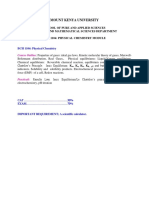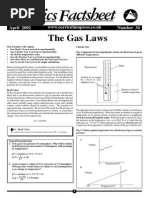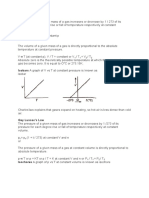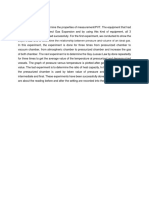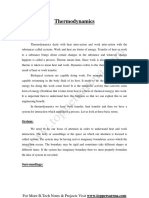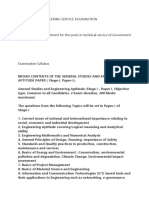Module 4 Part 1 Engineering Thermidynamics i
Uploaded by
nyasetiaarnoldModule 4 Part 1 Engineering Thermidynamics i
Uploaded by
nyasetiaarnoldENGINEERING THERMODYNAMICS I
Prof. J F Kanyua
Module 4 (Part 1)
1) Boyle’s Law
Date 1662
In France, Boyle’s Law may be referred to as Edme Mariotte Law.
During a change of state in which the mass and the temperature remain constant, the
volume varies inversely as the pressure.
P = Constant/V
pV = Constant (at Constant Temperature)
pdV + Vdp = 0
−𝑝𝑑𝑉 −𝐶 𝑑𝑉 𝑑𝑉
dp = = = −𝐶 𝑉 2
𝑉 𝑉 𝑉
𝑑𝑝 −𝐶
=
𝑑𝑉 𝑉2
As V 0 , P ∞
As V ∞ , P 0
TUM 07 November 2024 1 of 18
P
dp c
dv v²
P vs V
P vs 1/V
1/V
TUM 07 November 2024 2 of 18
P
P1 1
2
P2
3
P3
V
V1, V2 , V3
P1V1 = P2V2 = P3V3 = Constant
P = C/V
1/V
2) Charles’s Law
Jacques Charles (1747 - 1823)
Derived in 1787 (Before Laws of Thermodynamics)
It is also known as Gay-Lussac (1778 – 1850) Law.
The specific volume of gas (permanent) at constant pressure increases linearly with
the temperature measured on a uniformly divided mercury-in-glass thermometer.
TUM 07 November 2024 3 of 18
𝑣 P1
p2
p3
3) Charles’s Law and Absolute Temperature
P1
v P2
P3
Origin
V0 V0
V0
t
T
V = Ct + V0 (Vo = Volume at t = 0 for particular P). t = Celsius
−𝑉0
At V = 0 (hypothetical) t =
𝐶
Select temperature scale (T) so that V = CT where T is the temperature reckoned
from the new origin. The new origin is t = - 2730 𝐶.
Therefore T = t + 273K
TUM 07 November 2024 4 of 18
T is the absolute temperature. The new origin is the absolute zero of temperature.
Extrapolation gives an “Origin” at which v = 0. This is the same for all gases and is
at – 273.16 0C.
Expressing v as linear function of T:
V = CT
T = (t + 273.16) 0Kelvin
Origin is referred to as absolute zero of temperature. If v = 0, no further reduction is
possible since there is nothing left to reduce in temperature.
Charles’s Law based on absolute temperature: During the change of state of any gas
in which mass and pressure remain constant, the volume varies in proportion with
absolute temperature.
p
Boyle’s Law
2
A
Charles’s Law
Boyle’s Law: P1V1 = PAVA
VA = P1V1/PA
From Charles’s Law (Process A to 2) :
P2 = PA
TUM 07 November 2024 5 of 18
𝑉2 𝑉
= 𝑇𝐴
𝑇2 𝐴
T1 = TA (Boyle’s Law process 1 to A)
𝑉𝐴 𝑉
= 𝑇2
𝑇1 2
But VA= P1V1/PA
𝑃1𝑉1 𝑉2
=
𝑇1 𝑃2 𝑇2
𝑃1𝑉1 𝑃2 𝑉2
Or =
𝑇1 𝑇2
i.e. PV/T = Constant
V = mv (mass x specific volume)
𝑝𝑉
=C
𝑇
𝑝𝑣𝑚
=C
𝑇
𝑝𝑣 𝐶
=𝑚
𝑇
If we make m = 1kg, C/m = Another constant which is unique for each gas (say R)
pv = RT
Or pV =mRT
This is known as the ideal gas law and is closely obeyed by real gases:
R is known as the gas constant and has different values for different gases.
Units of R:
𝑝𝑣 𝑁
R = =( 𝑚2 ) ( m3/ kg) (1/K)
𝑇
TUM 07 November 2024 6 of 18
= N.m /kg – K
= J/ kg – K
The ideal gas law now allows us to predict the behaviour of a gas if:
➢ The volume remains constant
➢ The temperature remains constant
➢ The pressure remains constant
Units of Pressure
P = Force/Area = N/m2
Pascal = 1N/m2
Kilo-Pascal (kPa) = 1000 N/m2 =1 kN/m2
Mega-Pascal (MPa) = 106 N/m2 = 1000 kN/m2 = MN/m2
Bar = 105 N/m2 = 105 Pascal = 100 kPa
1 Bar = 0.1 MN/ m2 = 0.1 MPa
From pv =RT or PV = mRT
Apply Avogadro’s hypothesis:
The volume of 1 mole of any gas is the same as the volume of 1 mole of any other
gas, when the gases are at the same temperature and pressure.
PV = mRT = NMRT
PV/NT = MR is Constant for all gases.
MR is given the symbol MR = R0 where R0 is the universal gas constant (or the molar
gas constant).
Units of R0 = :
pV = mRT = NMRT = (MR) NT
= R0NT
TUM 07 November 2024 7 of 18
R0 = PV/NT = (N/m2)(m3)/ mole – K
R0 = N- m / mole –K
R0 = 1000 N – m /1000 mole – K
R0 = 1000 Joule /1000 mole – K
R0 = kJ /kmole – K
R0 = 8.3143 kJ /kmole – K
Note:
pV = NMRT = NROT
V = NROT/ P
vN = ROT/ P (Volume of 1 mole)
If T and P are constant, vN is the same for all gases.
If we plot pv versus T with NRo = constant by taking, say N = 1 kmole; then the
Charles’s Law plots of V versus t for constant P will collapse into a single line with a
gradient equal to (NRo).
Thus the ideal gas law can be used to determine absolute 0 of temperature and the
unit of Kelvin Degree.
4) Kelvin Scale
➢ Kelvin Scale is designed so that zero degrees Kelvin is defined as absolute zero,
which is a hypothetical temperature at which all molecular movement ceases.
➢ Celsius Scale
AKA Centigrade Scale
Named after Anders Celsius (1701 – 44) who was the inventor of the scale. Lower
Reference fixed point: Melting point of pure ice – (Designated 0C)
Upper Reference point: Boiling point of pure water (Designated 100 0C)
➢ Boiling and freezing Points are defined for 1 standard atmosphere (because
boiling and freezing temperature is influenced by the pressure).
TUM 07 November 2024 8 of 18
➢ The Kelvin: Defined as the fraction 1/273.16 of the thermodynamic temperature
of the triple point of water (Exactly 0.01 0C). In other words it is defined such that
the triple point of water is exactly 273.16 0K.
Note:
The gas laws presented hereinbefore are applicable at relatively low pressures and
relatively high temperatures.
PV
P0V0
K
T0 = 273.160K
Taz = 00K t0 = 00C
taz = - 273.160C
pV = R0NT
Slope = poV0/T0 = R0N
TUM 07 November 2024 9 of 18
Dalton’s Law
Each gas in a mixture of gases has the same properties as if it alone filled/occupied
the total volume (container)
Characteristics Equation of a Perfect Gas
General changes of state of a gas in which p, υ and T are allowed to change (unlike
in Boyle’s Law and Charles’s Law)
P
1
2
3
V
Process 1 -2: Boyle’s Law
𝑃1 𝑉1
𝑃1 𝑉1 = 𝑃2 𝑉2 ∴ 𝑉2 = 𝑃2
Process 2 – 3: Charles’s Law
𝑉3 𝑇3
=
𝑉2 𝑇2
During process 1 – 2, 𝑇1 = 𝑇2
𝑉3 𝑇3 𝑉3 𝑇1
∴ = ∴ 𝑉2 =
𝑉2 𝑇1 𝑇3
𝑃1 𝑉1 𝑃1 𝑉1
𝑉2 = =
𝑃2 𝑃3
𝑉3 𝑇1 𝑃1 𝑉1
∴ 𝑉2 = =
𝑇3 𝑃3
𝑉3 𝑃3 𝑃1 𝑉1 𝑃2 𝑉2
Or = = −−−−−−−−
𝑇3 𝑇1 𝑇2
𝑃.𝑉
I.e. = 𝐶𝑜𝑛𝑠𝑡𝑎𝑛𝑡
𝑇
V = mυ υ = Specific Volume
TUM 07 November 2024 10 of 18
𝑃𝑚υ
∴ = 𝐶𝑜𝑛𝑠𝑡𝑎𝑛𝑡
𝑇
𝑃υ 𝐶𝑜𝑛𝑠𝑡𝑎𝑛𝑡
= = 𝑅: 𝑆𝑝𝑒𝑐𝑓𝑖𝑐 𝐶𝑜𝑛𝑠𝑡𝑎𝑛𝑡 𝑓𝑜𝑟 1𝑘𝑔 𝑜𝑓 𝑔𝑎𝑠
𝑇 𝑚
𝑃υ
=𝑅
𝑇
𝑃V
= 𝑚𝑅 𝑜𝑟 𝑝𝑉 = 𝑚𝑅𝑇
𝑇
𝑁
𝑃𝑉 .𝑚3 𝑁−𝑚
𝑚2
Units: 𝑚 = =
𝑇 𝐾.𝑘𝑔 𝐾−𝑘𝑔
𝐽
R=
𝑘𝑔−𝐾
R = Work done when 1 kg of gas is heated at constant pressure through 1 degree rise
of temperature.
𝑚𝑅𝑇 𝑃2 𝑇2
➢ Constant Volume Pressure p = = 𝐶𝑇, =
𝑉 𝑃1 𝑇1
𝑚𝑅𝑇 𝑉2 𝑇2
➢ Constant Pressure Process: 𝑉1 = = 𝐶𝑇 , =
𝑃 𝑉1 𝑇1
➢ Constant Temperature Process: PV =C , 𝑃2 𝑉2 = 𝑃1 𝑉1
Polytropic Process
The constant volume, and constant pressure processes are limiting cases of a more
general type of process in which υ and p change but in a specified manner.
In many real processes, expansion or compression may be described by 𝑝υ𝑛 =
𝐶𝑜𝑛𝑡𝑎𝑛𝑡 where n is the index of expansion or compression.
𝑝υ𝑛 = 𝐶𝑜𝑛𝑡𝑎𝑛𝑡 is the polytropic process
Case 1: 𝑛 = 0: 𝑝υ0 = 𝐶𝑜𝑛𝑡𝑎𝑛𝑡 , υ0 = 1 ∴ 𝑝 = 𝐶𝑜𝑛𝑡𝑎𝑛𝑡
1
𝐶𝑜𝑛𝑡𝑎𝑛𝑡
Case 2: n=∞ 𝑝υ𝑛 = 𝐶𝑜𝑛𝑡𝑎𝑛𝑡 𝑝 𝑛 υ = 𝐶𝑜𝑛𝑡𝑎𝑛𝑡 υ= 1
𝑝𝑛
TUM 07 November 2024 11 of 18
1
if n = ∞ , 𝑝∞ 𝑃0 = 1 ∴ υ = Constant
Case 3: n = 1 𝑝υ𝑛 = Constant 𝑝υ1 = Constant pυ = Constant = mRT
∴ 𝐶𝑜𝑛𝑠𝑡𝑎𝑛𝑡 𝑡𝑒𝑚𝑝𝑒𝑟𝑎𝑡𝑢𝑟𝑒 𝑝𝑟𝑜𝑐𝑒𝑠𝑠
P n
n=0
n=∞
Availability and Gibbs Function
Josiah Willard Gibbs
Born 1839
Died 1903
Physics Chemistry, Mathematics
Gibbs Entropy
Gibbs Free Energy
Gibbs-Helmholtz Equation
Gibbs-Durham Equation
Gibbs Isotherm
Gibbs Inequality
Availability
TUM 07 November 2024 12 of 18
Recall: In the most engines studied, heat was rejected at condenser temperature and
pressure. Heat rejection is at a temperature higher than the temperature of the
surroundings.
If the surroundings are at constant temperature T0 and pressure P0, the maximum
work which can be done by the system interacting with the environment is if the
heat rejection is at (T0, P0).
Availability: Availability is a measure of this maximum theoretical useful work (w net)
Recall: Heat reservoir – A heat source of infinite capacity and therefore invariably at
temperature.
Recall: Heat is a system of infinitely large capacity and therefore its condition
remains at (T0, P0).
Recall: Carnot Cycle: Heat input at constant upper temperature (T) and heat rejection
at constant lower temperature (T0).
Recall Carnot Cycle Efficiency: is the highest possible.
ηcarnot= (Q1-Q2)/Q1 =1- Q2/Q1
TUM 07 November 2024 13 of 18
Q2/Q1 = T2/T1
∴ ηcarnot= 1- (T2/T1)
Availability is the Wnet done in a Carnot Cycle when heat source is at T1 and makes
available heat amount Q1
∴ Availability = ηCARNOT x Q1
= Q1 x (T1-T2)/T1
Recall: Power cycles studied so far involve a secondary fluid (working fluid) being
taken in a cycle while the complete system is not undergoing a cycle process.
When working fluid has reached (T0, P0) i.e. at equilibrium with surroundings the
working fluid is not able to produce further work.
TUM 07 November 2024 14 of 18
Availability for Closed System
Consider cylinder and piston system.
Consider initial state as (T1, P1)
Surroundings at (T0, P0)
Recall Reversible Non-flow Energy Equation:
Q- W = dU
Applying this equation to the working fluid:
W1 = Q- dU = Q-(U0-U1)
The piston does work on the surroundings equal to:
W’= p0(V0- V1)
The useful work fluid done on the piston is:
W = W1-W’
= Q-( U0-U1) - p0(V0- V1)
= Q-( U0+ p0V0) –( U1 + p0V1)
Recall: Principals of increase in entropy of the system (dS) and of the surroundings
(dS0)
dS + dS0 ≥ 0
Q = ≤ T0 +(S0-S1)
Equality holds if the process is irreversible.
W = Q -(U0+ p0V0) + (U1 + p1V1)
TUM 07 November 2024 15 of 18
If Q ≤ T0(S0-S1)
Then W ≤ - (U0+ p0V0) + (U1 + p1V1) + T0 (S0-S1)
W ≤ (U1 + p1V1 - T0 S1) – (U0+ p0V0 - T0 S0)
Equality holds if process is reversible.
∴ Wmax = (U1+ p1+v1- T0 S1) – (U0+ p0V0 - T0 S0)
∴ Wmax = A1 – A0
A = U + P0V - T0S Non-flow availability function
A is a property of the system and also a property of the surroundings.
Gibbs function
G = H – TS
G 0 = HO - T 0 S 0
= U0 + p0V0 - T0 S0
= A0
Example
1) Application to case where initial state (p0 T1) = (p0 T0)
This represents successive isentropic compression and expansion of a gas
yielding zero net work.
2) Application to case where saturated liquid is changed to saturated vapour at
constant p & T.
Wmax = (ufo + p0vfo- T0 Sf0) – (ugo+ p0vgo- T0 Sgo)
h= pv-u
Wmax = (hfo- hgo) - ToSfo + T0 Sgo
= -((hgo- hfo) + To(Sgo – Sfo)
Wmax = - (hfgo - T0 Sfgo)
Wmax = hfgo = T0 Sfg
TUM 07 November 2024 16 of 18
∴ Wmax = 0 i.e. no useful work can be derived from this process.
Availability for Steady –Flow Open System
Recall: Q = W = m(dh+dc2/2 + gdz)
W = - m (dh + dc2/2 + gdz) + Q
W = - m[ (h0 – h1) +( C02 – C12)/2 + g(z0 – z1]
= +Q
W= - m(h0 + C02/2 +gzo)
- m(h1 + C12/2 + gz1) + Q
TUM 07 November 2024 17 of 18
Q = T0(S0-S1)
∴ W ≤ - (H0 – H1) +T0(S0-S1)
∴ Wmax = (H1 - T0 S1) – (H0 – T0S0)
= B1-B0
Note:
B and A differ in the pressure term.
B= H - T0S = U +Pv- T0S
A= U +p0V - T0S
When state 1 is the same as state 0, then A = B = G
Helmholtz Function
TUM 07 November 2024 18 of 18
You might also like
- ME 161: Introduction To Mechanical Engineering: Asif KabirNo ratings yetME 161: Introduction To Mechanical Engineering: Asif Kabir21 pages
- Unit-II Single Phase and Two-phase SystemNo ratings yetUnit-II Single Phase and Two-phase System17 pages
- Gas Laws: Temperature: Co-Ordinates: Boyle's LawNo ratings yetGas Laws: Temperature: Co-Ordinates: Boyle's Law4 pages
- Boyle's Law: Important: Charles's Law Only Works When The Pressure Is ConstantNo ratings yetBoyle's Law: Important: Charles's Law Only Works When The Pressure Is Constant3 pages
- Class 11 Physics Kinetic Theory of Gases NotesNo ratings yetClass 11 Physics Kinetic Theory of Gases Notes32 pages
- 5.60 Thermodynamics & Kinetics: C W.mit - EduNo ratings yet5.60 Thermodynamics & Kinetics: C W.mit - Edu11 pages
- Charles - Law - Avogadros Law - Equation of StateNo ratings yetCharles - Law - Avogadros Law - Equation of State28 pages
- Isothermal Process: A Constant Temperature Process100% (1)Isothermal Process: A Constant Temperature Process11 pages
- 2023 12 02 Gaseous State Liverpool CollegeNo ratings yet2023 12 02 Gaseous State Liverpool College60 pages
- Notes Chapter 5 Physical States of Matter Reduced Syllabus 2020No ratings yetNotes Chapter 5 Physical States of Matter Reduced Syllabus 202018 pages
- SCH 215 Lecture 1 Notes - Copy - Copy (2)No ratings yetSCH 215 Lecture 1 Notes - Copy - Copy (2)9 pages
- CHE486 Lab 6 Property Measurement To Send WsNo ratings yetCHE486 Lab 6 Property Measurement To Send Ws23 pages
- cci operating system sample questions tum - Google SearchNo ratings yetcci operating system sample questions tum - Google Search4 pages
- Me8595 Te II Course File - Final - Unit 1 - 2022 - 23No ratings yetMe8595 Te II Course File - Final - Unit 1 - 2022 - 23196 pages
- Current Rating of Cables Installed in Deep or Ventilated TunnelsNo ratings yetCurrent Rating of Cables Installed in Deep or Ventilated Tunnels6 pages
- Experiment No.-04: Heat Balance On 4 Stroke Single Cylinder Diesel Engine AIMNo ratings yetExperiment No.-04: Heat Balance On 4 Stroke Single Cylinder Diesel Engine AIM8 pages
- Overall Heat Transfer Coefficient and Temperature ProfileNo ratings yetOverall Heat Transfer Coefficient and Temperature Profile12 pages
- Syllabus of Engineering Service ExaminationNo ratings yetSyllabus of Engineering Service Examination5 pages
- Heat Transfer: ME184443 (3 Credits) Marine Engineering Department ITS SurabayaNo ratings yetHeat Transfer: ME184443 (3 Credits) Marine Engineering Department ITS Surabaya34 pages
- Evaporation Condensation and Heat Transfer100% (2)Evaporation Condensation and Heat Transfer594 pages
- Unisim Design Tutorial For Chee470: Queen'S University Department of Chemical EngineeringNo ratings yetUnisim Design Tutorial For Chee470: Queen'S University Department of Chemical Engineering75 pages
- Syllabus For ESE: Subject Duration Max. MarksNo ratings yetSyllabus For ESE: Subject Duration Max. Marks4 pages
- Control Sequences For Chilled Water Systems - Consulting-Specifying EngineerNo ratings yetControl Sequences For Chilled Water Systems - Consulting-Specifying Engineer5 pages
- Coupling CFD and RSM To Optimize The Flow and Heat Transfer Performance of A Manifold Microchannel Heat SinkNo ratings yetCoupling CFD and RSM To Optimize The Flow and Heat Transfer Performance of A Manifold Microchannel Heat Sink20 pages
- FINAL PHYSICS 7 (CG-unpacked-objectives)No ratings yetFINAL PHYSICS 7 (CG-unpacked-objectives)9 pages
- Technical Electives Availability Updated 2020No ratings yetTechnical Electives Availability Updated 20204 pages
- Me 324 - Heat Transfer Review Sheet - Final Exam - Chapters 1, 2, and 3 (Sections 3.1 To 3.4)No ratings yetMe 324 - Heat Transfer Review Sheet - Final Exam - Chapters 1, 2, and 3 (Sections 3.1 To 3.4)1 page
- ME 161: Introduction To Mechanical Engineering: Asif KabirME 161: Introduction To Mechanical Engineering: Asif Kabir
- Boyle's Law: Important: Charles's Law Only Works When The Pressure Is ConstantBoyle's Law: Important: Charles's Law Only Works When The Pressure Is Constant
- Isothermal Process: A Constant Temperature ProcessIsothermal Process: A Constant Temperature Process
- Notes Chapter 5 Physical States of Matter Reduced Syllabus 2020Notes Chapter 5 Physical States of Matter Reduced Syllabus 2020
- Ian Talks Thermodynamics A-Z: PhysicsAtoZ, #3From EverandIan Talks Thermodynamics A-Z: PhysicsAtoZ, #3
- cci operating system sample questions tum - Google Searchcci operating system sample questions tum - Google Search
- Me8595 Te II Course File - Final - Unit 1 - 2022 - 23Me8595 Te II Course File - Final - Unit 1 - 2022 - 23
- Current Rating of Cables Installed in Deep or Ventilated TunnelsCurrent Rating of Cables Installed in Deep or Ventilated Tunnels
- Experiment No.-04: Heat Balance On 4 Stroke Single Cylinder Diesel Engine AIMExperiment No.-04: Heat Balance On 4 Stroke Single Cylinder Diesel Engine AIM
- Overall Heat Transfer Coefficient and Temperature ProfileOverall Heat Transfer Coefficient and Temperature Profile
- Heat Transfer: ME184443 (3 Credits) Marine Engineering Department ITS SurabayaHeat Transfer: ME184443 (3 Credits) Marine Engineering Department ITS Surabaya
- Unisim Design Tutorial For Chee470: Queen'S University Department of Chemical EngineeringUnisim Design Tutorial For Chee470: Queen'S University Department of Chemical Engineering
- Control Sequences For Chilled Water Systems - Consulting-Specifying EngineerControl Sequences For Chilled Water Systems - Consulting-Specifying Engineer
- Coupling CFD and RSM To Optimize The Flow and Heat Transfer Performance of A Manifold Microchannel Heat SinkCoupling CFD and RSM To Optimize The Flow and Heat Transfer Performance of A Manifold Microchannel Heat Sink
- Me 324 - Heat Transfer Review Sheet - Final Exam - Chapters 1, 2, and 3 (Sections 3.1 To 3.4)Me 324 - Heat Transfer Review Sheet - Final Exam - Chapters 1, 2, and 3 (Sections 3.1 To 3.4)












